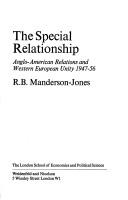| Listing 1 - 7 of 7 |
Sort by
|

ISBN: 0297994220 9780297994220 Year: 1972 Publisher: London Weidenfeld and Nicolson
Abstract | Keywords | Export | Availability | Bookmark
 Loading...
Loading...Choose an application
- Reference Manager
- EndNote
- RefWorks (Direct export to RefWorks)
United States --- Great Britain --- Europe --- Foreign relations --- History --- 1945-1989 --- 1945 --- -United States --- -United States - Foreign relations - Great Britain --- Great Britain - Foreign relations - United States --- Great Britain - Foreign relations - 1945 --- -Europe - History - 1945
Book
ISBN: 0582330580 Year: 1979 Publisher: London Longman
Abstract | Keywords | Export | Availability | Bookmark
 Loading...
Loading...Choose an application
- Reference Manager
- EndNote
- RefWorks (Direct export to RefWorks)
Book
Abstract | Keywords | Export | Availability | Bookmark
 Loading...
Loading...Choose an application
- Reference Manager
- EndNote
- RefWorks (Direct export to RefWorks)
Article
Abstract | Keywords | Export | Availability | Bookmark
 Loading...
Loading...Choose an application
- Reference Manager
- EndNote
- RefWorks (Direct export to RefWorks)
Adrenocortical. --- Chicken. --- Coping strategies. --- Coping strategy. --- Coping. --- Quail. --- Selection. --- Strategies. --- Strategy.
Book
Year: 1957 Publisher: Stanford, Calif. Stanford University Press
Abstract | Keywords | Export | Availability | Bookmark
 Loading...
Loading...Choose an application
- Reference Manager
- EndNote
- RefWorks (Direct export to RefWorks)
Article

Abstract | Keywords | Export | Availability | Bookmark
 Loading...
Loading...Choose an application
- Reference Manager
- EndNote
- RefWorks (Direct export to RefWorks)
Article
Year: 2001
Abstract | Keywords | Export | Availability | Bookmark
 Loading...
Loading...Choose an application
- Reference Manager
- EndNote
- RefWorks (Direct export to RefWorks)
Social recognition is essential for the maintenance of a stable group structure. Failure to recognise familiar conspecifics in social groups of juvenile pigs may initiate agonistic encounters that can compromise welfare and productivity. Current housing systems may allow build up of atmospheric ammonia that might, in turn, interfere with the olfactory system and compromise olfactory perception. In the present study, 16 juvenile pigs were housed in fresh air while another 16 pigs were kept in an ammoniated atmosphere (approximately 36 ppm) for 1 week prior to test and another week during testing. We then assessed the role of olfaction in social recognition and determined whether chronic exposure to ammonia compromised discrimination based on olfactory perception by comparing the pigs' responses to selected cues from a familiar and an unfamiliar pig presented simultaneously in separate chambers of a modified Y-maze in each of two test situations (near, remote). Visual, auditory, olfactory, and tactile cues were all provided in the "near" test situation; here, the stimulus pigs were presented in two separate chambers behind clear perspex walls containing an aperture that allowed nose-to-nose contact between the test and stimulus pigs. On the other hand, the "remote" test provided only olfactory cues via air passed from the chambers containing the stimulus pigs into the test chamber. Each test lasted 5 min and the pigs' behaviour was recorded via overhead video cameras; we then measured the accumulated times spent near and the numbers of visits made to the familiar and the unfamiliar stimulus pigs as well as the transitions between them. Overall, pigs made more visits to and spent significantly longer near both the stimulus pigs in the near test than in the remote one (ANOVA, PPPP<0.05). The present results suggest that pigs from both treatment groups employed olfactory cues in social recognition, but that chronic exposure to ammonia did not interfere with
Ability. --- Agonistic. --- Ammonia. --- Auditory. --- Behaviour. --- Conspecific. --- Contact. --- Cues. --- Discrimination. --- Exposure. --- Failure. --- Group. --- Housing system. --- Housing. --- Kept. --- Maintenance. --- Olfaction. --- Olfactory cues. --- Olfactory. --- Perception. --- Pig. --- Pigs. --- Preference. --- Preferences. --- Productivity. --- Recognition. --- Response. --- Responses. --- Situations. --- Social recognition. --- Social. --- Stimulus. --- System. --- Systems. --- Test. --- Time. --- Treatment. --- Video. --- Welfare. --- Y-maze.
| Listing 1 - 7 of 7 |
Sort by
|

 Search
Search Feedback
Feedback About UniCat
About UniCat  Help
Help News
News